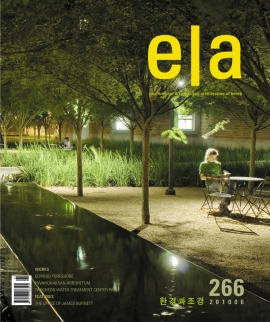James Burnett, The Office of James Burnett
Office of James Burnett은 1989년에 설립되어 올해로 창립 21주년을 맞았다. 지난 20여년 동안 추구해온 기업운영 철학과 디자인 철학에 대해 알고 싶다.
나는 세계적인 Planning & Design 회사 CRSS에서 5년간 근무 후 지난 1989년 휴스턴에 지금의 회사를 설립했다. CRSS에서의 근무는 나에게 매우 유익한 경험이었고 나의 회사에 대한 구성이나 규모에 대해 매우 깊고 신중하게 생각할 수 있는 계기가 되었다. 당시 나는 양쪽의 사무실이 규모가 크지 않거나 민첩하게 움직일 수 있을 때 최상의 업무능력과 기능을 발휘할 수 있음을 깨달았다. 우리는 지속적으로 우리의 생각을 여러 가지 방법을 통해 교환하고 있다. 방법론적으로 그 형태는 중요하지 않고 어떤 방법이 가장 편리한가를 생각한다. 그래서 트레이싱 종이 위의 간단한 스케치나 휴대전화 사진, 어떤 사람의 블로그 혹은 인터넷상의 참신한 동영상을 이용하고 있다. 우리 직원들은 디자인에 관해서 상당히 열정적이며 그들의 왕성한 아이디어가 많은 이윤을 창출하고 있다.
사업가로서 나는 우리의 프로젝트를 위해 채용된 사람이 과연 옳은 선택이었는지 확신하는데 매우 조심스럽다. 의욕을 가진 팀원을 보유한 다는 것은 우리 회사에 있어 매우 중요한 문제이다. 우리는 빠른 성장과 대규모 성장 같은 말에 의미를 두지 않는다. 이러한 점은 단기적으로는 가끔 우리에게 해가 되기도 하지만, 장기적으로 봤을 때 주어지는 이득은 매우 값진 것이기 때문이다. 중요한 사실은 우리는 우리가 좋아하고 좋은 교류 관계를 즐길 수 있는 앞선 건축가들과 함께 일하는 것이며, 항상 장래의 대형 프로젝트에 대하여 생각하는 것이다.
작품에서 공간요소나 소재의 디테일을 강조하고 있는 것 같다. 조경공간에서 디테일이 갖는 의미나 중요성은 무엇인가?
강한 공간배열과 심도 있는 디테일 디자인은 우리 회사가 하는 일의 핵심이다. 우리는 매년 5개에서 10개 정도의 새로운 정원을 설계하고 있고 건물과 연계된 프로젝트들을 즐기고 있는 회사로서 명성을 쌓아가고 있다. 우리 팀은 건물주들, 건축가 그리고 또 다른 영역에서 각각의 프로젝트에 의미를 부여할 수 있는 디자이너들과 밀접하게 일을 한다. 디테일 디자인은 때론 간과되기도 하지만 프로젝트 디자인에 있어 아주 중요한 측면이 있다. 나는 항상 직원들에게 모든 프로젝트의 문제점들을 충분히 이해하고 어떻게 하면 모든 조각들이 잘 맞추어 질런지 발견하는 시간을 갖으라고 독려한다. 이러한 문제들은 현장에서 자주 나타나는 것이지만 대개 공사가 시작되기도 전에 스튜디오 내에서 해결될 수 있다.
뚜렷한 장소성을 만들어내는 것 역시 프로젝트의 성공여부를 결정한다. 이것은 여러 방법에 의해 나타날 수 있다. 부지가 속한 지역의 자연패턴이 부지 내에서 모방될 수도 있고, 문화 행사나 전통들도 디자인 요소의 출발점으로 끌어올 수도 있을 것이다. 어떤 때에는 건축이 프로젝트의 중심이 되고 우리는 그러한 디자인 언어들을 조경으로 연장시킨다. 거기에는 이러한 목표를 성취하기 위한 많은 다양한 방법이 있으며 근면함, 끊임없는 연구 그리고 디자인 안목이 요구된다.
It has been the 21st anniversary of the office of James Burnett since established in 1989. What is your philosophy of designing projects and operating business over 20 years?
The firm was founded in Houston in 1989 after I left my position at the international planning and design firm CRSS, where I practiced for 5 years as a landscape architect. It was a profoundly informative experience and it made me very conscious of size and composition of my own firm; I find both offices tend to perform and function best when they are small and agile. We continually exchange ideas in whatever media format is most convenient, whether it is a rough sketch on trace paper, a cell phone photo, someone’s favorite blog or just a cool video making the rounds on the internet. Our staff is very passionate about design and the frequent exchange of ideas is something that everyone benefits from.
As a businessman, I have been very careful to be sure that the projects that we take on are right for us ? keeping the team motivated is critical to our firm. It’s also important that we do not live beyond our means or grow too large too fast. While this has occasionally inconvenienced us in the short term, the long term benefits have been invaluable. We work on projects that we like, enjoy good relationships with leading architects and are always thinking about the next big project.
It strongly seems that most projects emphasize space elements or material details. What is your opinion about the importance or meaning which has details in landscape space?
Strong spatial order and thoughtful detail design is at the heart of our work. We construct 5-10 new gardens every year and have built our reputation as a firm that enjoys building projects. Our team works closely with the owner, architect and the other designers on the team to create meaning in the project. Detail design is a critical ? and often overlooked- aspect of project design. I always encourage my team to take the time to understand the problem and to take the time to figure out how all the pieces fit together. Sometimes these things turn up in the field but more often than not problems can be resolved in the studio before construction ever begins.
Creating a distinct sense of place is also critical to the success of a project. This can occur on a number of levels ? natural patterns found in the region may be replicated on site; cultural events and traditions may be abstracted as a point of departure for a design element. At other times, the architecture becomes the central feature of the project and we extend that language into the landscape. There are many different ways to achieve this goal and all require diligence, lots of studies and an eye for design.
번역(Translation) _ 김무한(Moohan Kim)





